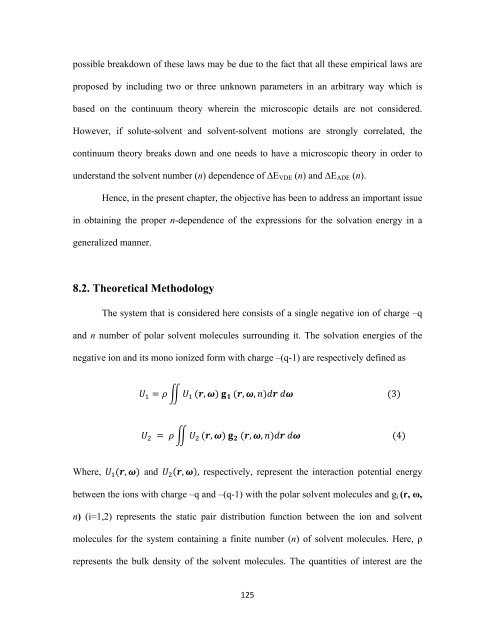CHEM01200604005 A. K. Pathak - Homi Bhabha National Institute
CHEM01200604005 A. K. Pathak - Homi Bhabha National Institute
CHEM01200604005 A. K. Pathak - Homi Bhabha National Institute
Create successful ePaper yourself
Turn your PDF publications into a flip-book with our unique Google optimized e-Paper software.
possible breakdown of these laws may be due to the fact that all these empirical laws are<br />
proposed by including two or three unknown parameters in an arbitrary way which is<br />
based on the continuum theory wherein the microscopic details are not considered.<br />
However, if solute-solvent and solvent-solvent motions are strongly correlated, the<br />
continuum theory breaks down and one needs to have a microscopic theory in order to<br />
understand the solvent number (n) dependence of ∆E VDE (n) and ∆E ADE (n).<br />
Hence, in the present chapter, the objective has been to address an important issue<br />
in obtaining the proper n-dependence of the expressions for the solvation energy in a<br />
generalized manner.<br />
8.2. Theoretical Methodology<br />
The system that is considered here consists of a single negative ion of charge –q<br />
and n number of polar solvent molecules surrounding it. The solvation energies of the<br />
negative ion and its mono ionized form with charge –(q-1) are respectively defined as<br />
, , , <br />
3<br />
, , , <br />
4<br />
Where, , and , , respectively, represent the interaction potential energy<br />
between the ions with charge –q and –(q-1) with the polar solvent molecules and g i (r, ω,<br />
n) (i=1,2) represents the static pair distribution function between the ion and solvent<br />
molecules for the system containing a finite number (n) of solvent molecules. Here, ρ<br />
represents the bulk density of the solvent molecules. The quantities of interest are the<br />
125
















